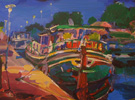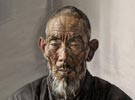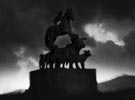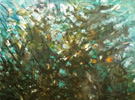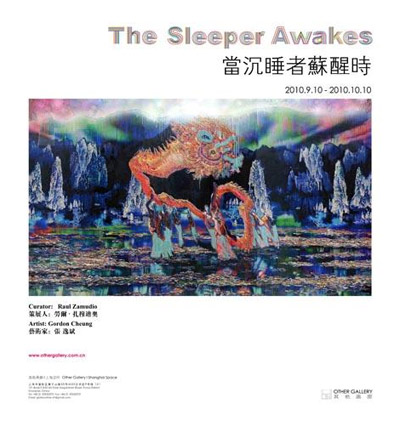
展览时间:2010-09-10 ~ 2010-10-10
展览地点:其他画廊
策 展 人:劳尔.扎穆迪奥
参展艺术家:张逸斌
主办单位:其他画廊
展览介绍:
伦敦艺术家张逸斌的个展“当沉睡者苏醒时”收录了他的绘画、雕塑和动画作品。本次展览的题目取自威尔斯(H.G. Wells)发表于1910年的同名科幻小说。故事情节围绕着一位名叫格拉汉姆的男子展开,他在1897年的伦敦坠入长眠,一睡就是203年。
张逸斌采用了威尔斯小说的叙述方式来象征当今的全球化状况。但这个主题不仅仅构成了其作品的内容,也是艺术家的形式策略。在故事中,二百多年的银行复利使格拉汉姆成为富翁,而张逸斌的十幅精彩绝伦的肖像《2008年十大亿万富翁》(Top Ten Billionaires, 2008,2009)即影射了巨额的财富。其中,艺术家将比尔•盖茨和威廉•巴菲特等十位富翁的肖像画在股票单据上,这既象征了当代全球化经济贸易,也象征着无序的市场经济潜在的问题。
但是,张逸斌在这些单据上还画了其他图像,象征着格拉汉姆醒来之时所面对的那个虚幻的世界,他看到了牛头怪和龙——两个灵异分别代表了东西方世界这两极。这两种宇宙观的原型也被象征性地引入了当代欧美与亚洲地缘政治的对抗中。
本次展览还将展出一系列描绘作为战利品的动物绘画,表达了艺术家对自然商品化的态度。威尔斯的故事是反乌托邦的,而张逸斌用镜子、荧光灯和翻铸的动物骨骼创作的雕塑则暗示着科学技术的疯狂运用给自然环境带来的灾难。围绕着展览外部的是一个名为《四骑士》(The Four Riders,2009)的系列动画影像作品。《四骑士》象征着《启示录》中的传道者约翰所见的“天启四骑士”,他们象征着战争、死亡、瘟疫和饥荒。张逸斌的《四骑士》也具有这样的暗示:每部影像作品中都有一个牛仔骑着公牛在背景音乐——Doors乐队的《尽头》(The End)——中不停地转圈。这首经久不衰的歌曲也曾被导演弗朗西斯•福特•科波拉(Francis Ford Coppola)用在了电影《现代启示录》(Apocalypse Now,1979)中。
The Sleeper Awakes is a solo exhibition of paintings, sculptures, and animation works by London-based artist Gordon Cheung. The exhibition’s title is culled from H.G. Wells’ similarly titled science fiction story published in 1910. The plot revolves around a man named Graham who falls into a catatonic sleep in London in 1897 and awakes 203 years later.
Cheung uses Wells’ tale as narrative touchstone to address conditions of contemporary globalization. But it is not only the content of Cheung’s artworks that engage this but the artist’s formal strategies as well. In the story, Graham becomes a wealthy man through compound interest in his bank account that has accrued for over two centuries. Mega-wealth is alluded to in Cheung’s riveting 10 portrait piece titled Top Ten Billionaires, 2008 (2009). The portraits include Bill Gates, William Buffet and 8 others whose likenesses are painted on stock listings. The stock listings are an index of contemporary global economic trading and potential abuse of unregulated financial markets, but Cheung has also painted other imagery on them that symbolizes the unreal world that Graham has awoken to: the Minotaur and the dragon. Both of these mythological creatures reflect polarities in respectively representing the West and the East. They are two cosmic archetypes symbolically engaged in contemporary geopolitical rivalry between Europe/the U.S., and Asia.
There will also be exhibited a series of paintings of animals as trophies that comment on nature as commodity. H.G. Wells’ story is dystopian, and Cheung’s sculptures constituted from mirrors, florescent lights, and cast animal skulls bespeak of environmental cataclysm from technology gone amok. Rounding out the exhibition is a series of animated video works titled The Four Riders (2009). The Four Riders are analogues to the apocalyptic Four Horsemen envisioned by the Apostle John in the Book of Revelation. Like the Biblical horsemen who are divine harbingers of pestilence, death and destruction on earth’s final days, The Four Riders hint to this as well: each animation consists of a bull-riding cowboy endlessly riding in a circle as the Doors’ The End is faintly heard in the background. This iconic song was also used by Francis Ford Coppola in Apocalypse Now.
- 2011-04-30 ~ 2011-05-30出窍记·缪晓春个展
- 2011-04-29 ~ 2011-05-20静中人Figures of Silence —Michel Madore
- 2011-04-30 ~ 2011-05-14黑白
- 2011-05-28 ~ 2011-07-28四重奏——孟昌明水墨荷花作品展
- 2011-05-28 ~ 2011-06-24“远与近”意大利当代著名艺术家作品展
- 2011-05-28 ~ 2011-07-02底下有石头:杨心广个展
- 2011-05-21 ~ 2011-06-20湖滨诗境──Celest生态摄影展(续展)
- 2011-05-21 ~ 2011-06-05缓行——十二位八零后艺术家
- 2011-04-28 ~ 2011-06-05观天悟道——张国龙艺术巡展
- 2011-05-28 ~ 2011-07-10诺特·维塔尔:激浸

